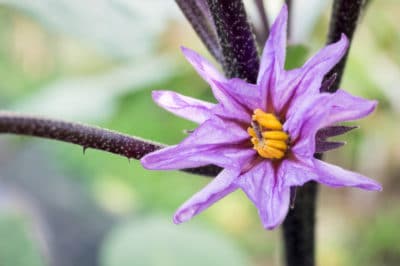Hand Pollinating Eggplant
If your eggplant flowers aren’t producing fruit, it could be a pollination problem. You can help them by hand pollinating the flowers yourself. You can do this in a couple of different ways.
- Shaking the flowers – By tapping the flowers gently, the pollen can transfer from the male to the female organs of the flower. This loosens the pollen, so it can move. Sometimes, if your area has humid weather, the pollen becomes sticky, preventing it from self-pollinating.
- Paint the pollen – Take a small paintbrush and gently swirl it inside the flower. This will move the pollen from the male to female parts of the plant. You can also use a cotton swab for this method.
Bee Pollination
The best method of eggplant pollination comes from bees. Wild bees usually pollinate the flowers enough to have an abundant eggplant crop. If you’re not seeing many bees in your garden, you can provide them by planting flowers around your garden that attract bees. For the best results, plant several different pollinators that attract bees at different times of the day.
The following flowering companion plants are favorites of bees:
- Alyssum
- Aster
- Geranium
- Black-eyed Susan
- Clover
- Poppies
Planting native wildflowers of your area is a natural way to attract bees, and they’ll continue growing every year. Native wildflowers make a natural, attractive habitat for your landscape, and provide wild bees with pollen and nectar.
Protect Eggplant Pollinators
Since bumblebees are the most effective pollinators of eggplants, it’s important to protect them while they’re visiting your garden. If your eggplants have any pests on the leaves, such as flea beetles, aphids or whiteflies, use organic methods to get rid of bugs get rid of bugs on your eggplants. Avoid pesticides that can harm the bee population in your garden.
One organic method of getting rid of pests on your eggplants is covering your plants with mesh nylon, which stops the pests from landing on your eggplants. Another method is to plant companion plants that attract flea beetles and other pests. A few of these trap crops are pumpkins and Blue Hubbard squash.
